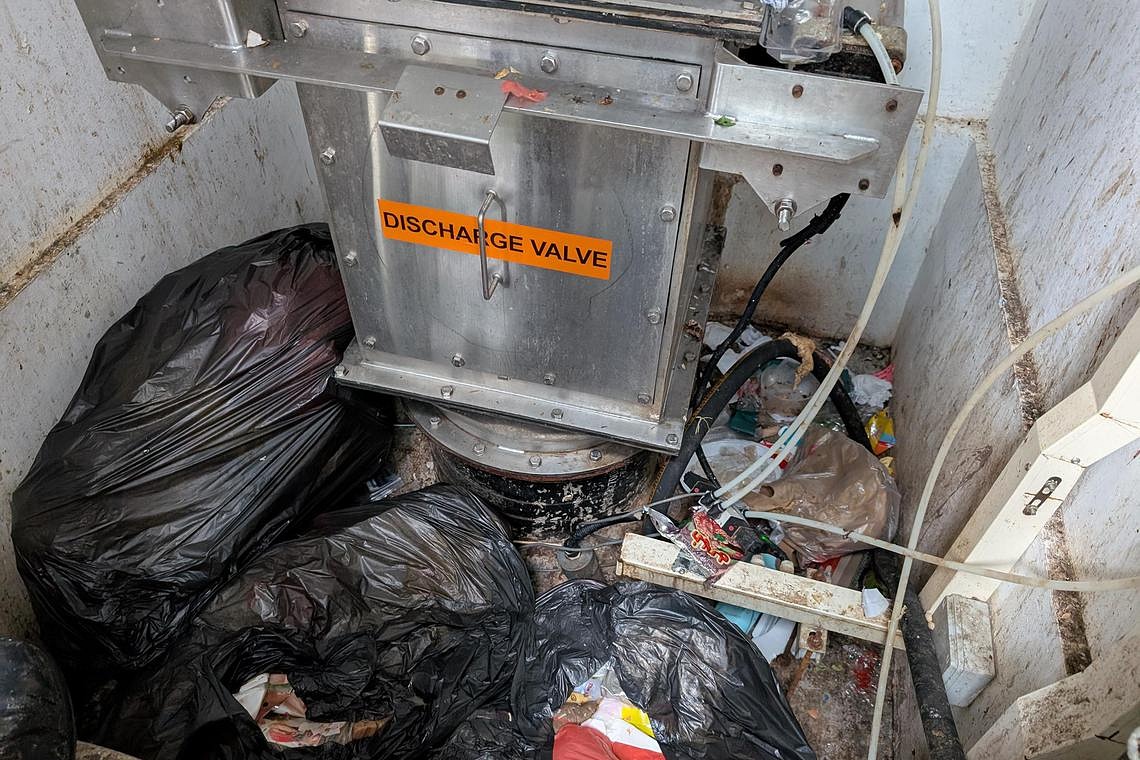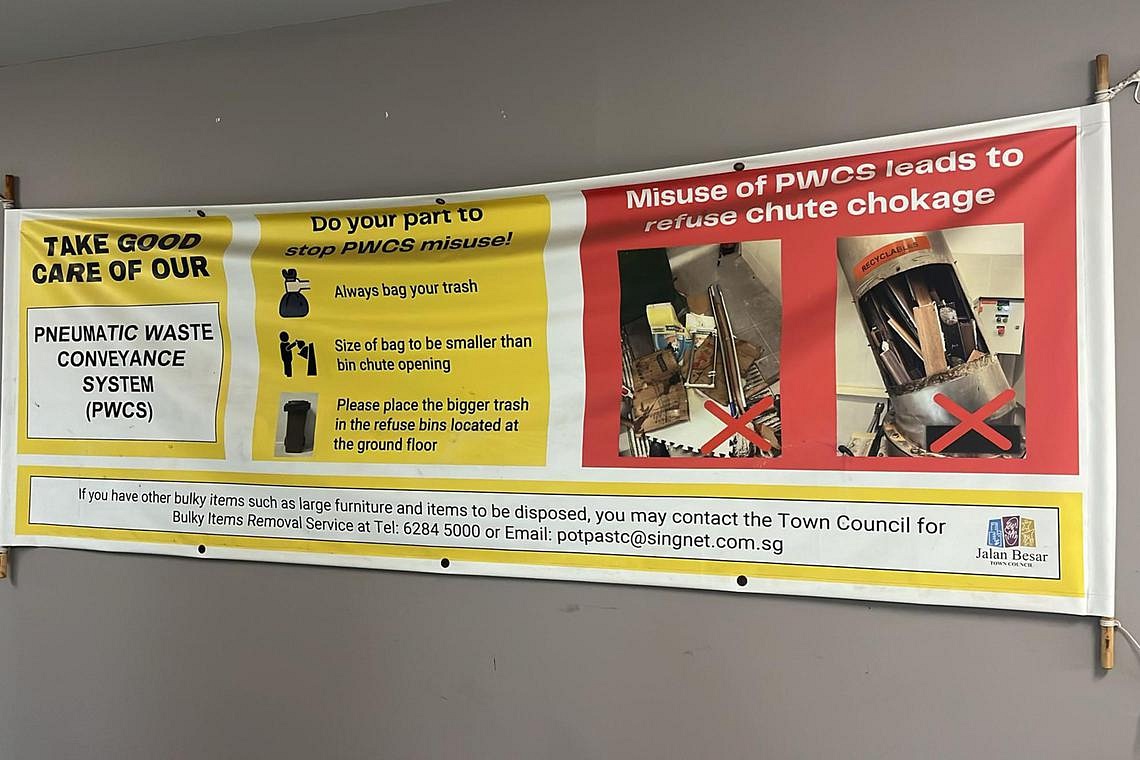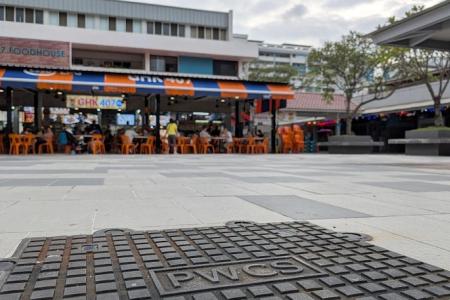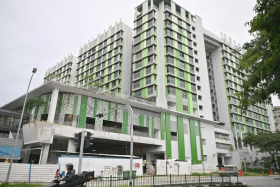Chokes hamper automated waste systems in some HDB estates
When a new automated waste system was installed in his Housing Board estate in Teck Ghee about a year ago, Mr Tan Wee Boon thought the noise caused occasionally by large rubbish bins hauled around his estate would become a thing of the past.
That is because the pneumatic waste conveyance system (PWCS) uses a vacuum-like suction to transport household waste via underground pipes to a centralised bin centre, where it is stored before being taken to incineration plants by waste disposal trucks.
In theory, workers are no longer needed to manually collect the refuse from rubbish chutes at individual blocks.
But soon after his estate started using the PWCS in 2024, Mr Tan, 40, still noticed workers manually removing rubbish from the chutes at the foot of the blocks in his area.
“The workers have to regularly open the chutes and take trash out because they get choked, especially during festive periods,” said the engineer, who has lived in Teck Ghee for more than two decades.
“It’s very unfortunate that we have automated systems to improve how things are done, but we have to resort to old methods because people are not using the system correctly.”
While HDB did not provide the number of reports of PWCS chokes it has received in recent years, residents and a contractor that maintains such systems told The Straits Times that the improper disposal of bulky items and renovation debris are causing frequent chokes that happen almost daily in some areas.
In response to queries from ST, HDB said on Jan 31 that PWCS chokes are more prevalent in their first year of operation as residents carry out renovations and move in progressively.
The chokes are often caused by indiscriminate dumping of renovation debris into the PWCS chutes, and by large cardboard boxes and packaging materials used for home appliances and other deliveries, added the public housing agency.
The PWCS has been installed in about 40 HDB precincts in Ang Mo Kio, Bukit Batok, Choa Chu Kang, Jurong East, Punggol, Sengkang, Tampines, Tengah, Toa Payoh, Woodlands and Yishun, said HDB. These precincts comprise Build-To-Order (BTO) projects, and older blocks retrofitted with the PWCS.
The system was test-bedded at some HDB blocks in Kim Keat, Choa Chu Kang and Clementi before being rolled out on a larger scale in Yuhua in 2015.
Residents of two estates in Bidadari and Ang Mo Kio, where the PWCS became fully operational in the past year, said they sometimes cannot open the refuse chute hoppers in their blocks due to chokes, and have seen workers manually clearing the chutes.
A contractor who supplies and maintains the PWCS in several HDB precincts said his workers have to manually remove rubbish from the chutes and pipes in some estates almost daily, after the PWCS was recently installed.
The workers, who are alerted to chokes by sensors in the PWCS, often find cardboard boxes, wooden planks, paint cans and pieces of furniture in chutes and pipes, said the contractor. He spoke to ST on condition of anonymity.
But unlike the Bidadari residents who had to put up with foul smells from a choked PWCS in 2021, none of the residents interviewed complained about odours caused by the chokes, although some said they often see many flies circling the chutes when they are opened.
When ST visited the Teck Ghee estate in Ang Mo Kio on Jan 20, two workers were manually collecting rubbish bags from the chutes at the foot of each block. They then tossed them into green rubbish bins that they pushed to a bin centre.

Teck Ghee resident and engineer Anthony Lim, 60, said: “There are notices in different languages at our lift lobby about what people can and cannot throw into the chutes. But this is an old estate with many seniors, and they may not understand what the notices say, or can’t carry their larger items down to the bulky refuse point at the void deck.”
But the choking problem is not confined to older estates.
Financial consultant Lionel Tay said the rubbish chute of his block in Alkaff Breeze was often clogged when he first moved into the Bidadari BTO project in late 2024.
The 31-year-old said: “It was very, very bad when I first moved in. There were flies everywhere around the chute, and the cleaners would have to pull out the trash themselves. But the chokes happen less frequently now.”
Aljunied GRC MP Gerald Giam, who has asked about the system in Parliament, said he has received “occasional feedback” from residents in Tampines GreenGem – the first BTO project with a PWCS under the Aljunied-Hougang Town Council – about not being able to dispose of their rubbish down the chutes.
HDB said blockages in the PWCS tend to start decreasing after six to nine months, and they stabilise by the end of the first year of operation as residents settle in and become more familiar with the system.
HDB added that the PWCS in BTO projects tendered from June 2018 features full volume-control refuse chute hoppers, which prevent the disposal of large or long items into the refuse chutes, thereby reducing the incidence of chokes.
Mr Ong Gin Keat, director of sustainability and business development at Envcares, a waste management services provider, said: “The PWCS is designed to be quite a solid and reliable system. But all you need is one inconsiderate person and one item that should not be thrown into the chute for a choke to happen.
“There needs to be consistent education because it’s not just residents, but also their helpers and their contractors who need to know how to use the PWCS properly. If people still do not follow the guidelines, the authorities could explore introducing a warning system with enforcement actions.”
Mr Ong, who also chairs the board of non-profit organisation Zero Waste SG, warned that maintenance needs of the PWCS might increase due to frequent chokes, and this could add to the already high costs of running the energy-intensive system.
In November 2024, National Development Minister Desmond Lee, replying to a parliamentary question by Mr Giam about the costs and benefits of the PWCS, said that the current higher costs of using the system are primarily borne by the Government for infrastructure and system deployment, and by the town councils for operations and maintenance.
“In recognition of the higher costs incurred by town councils with PWCS precincts, HDB currently provides them with a grant, at $2 per month per dwelling unit served by the PWCS,” Mr Lee said.

HDB said it has been educating residents of BTO projects with the PWCS on the proper use of the system through roadshows and user guides distributed to them before they collect the keys to their flat. It has also put up notices and signs at chute hoppers and lift lobbies.
Bulky items such as cartons, renovation debris and foam packaging materials, and long objects such as umbrellas and broom sticks should not be thrown into the PWCS as they can cause chokes and break down the waste system, said HDB.
“Such careless and inconsiderate acts also cause disamenities and bring inconvenience to other residents. Renovation debris should be properly disposed of by the renovation contractors, while bulky waste can be disposed of at skip tanks provided in newly completed projects where available, or at bulky refuse disposal points provided by town councils,” it added.
HDB added that residents may contact their town council if they need help to dispose of their bulky items. It also reminded renovation contractors not to dump debris into the chutes, and said it will not hesitate to penalise errant contractors.
Dos and don’ts of using the pneumatic waste conveyance system
Do not throw:
- Bulky items such as cartons and pillows
- Long objects such as umbrellas and brooms
- Heavy objects such as potted plants and electrical appliances
- Renovation debris such as timber, bricks and cement
- Flammable items such as paint and kerosene, and burning objects (for example, charcoal with embers and cigarette butts)
Do:
- Bag your rubbish up to a size smaller than the hopper opening
- Extinguish burning items before throwing
- Throw bulky items at bulky refuse disposal points or contact your town council for help
Get The New Paper on your phone with the free TNP app. Download from the Apple App Store or Google Play Store now


